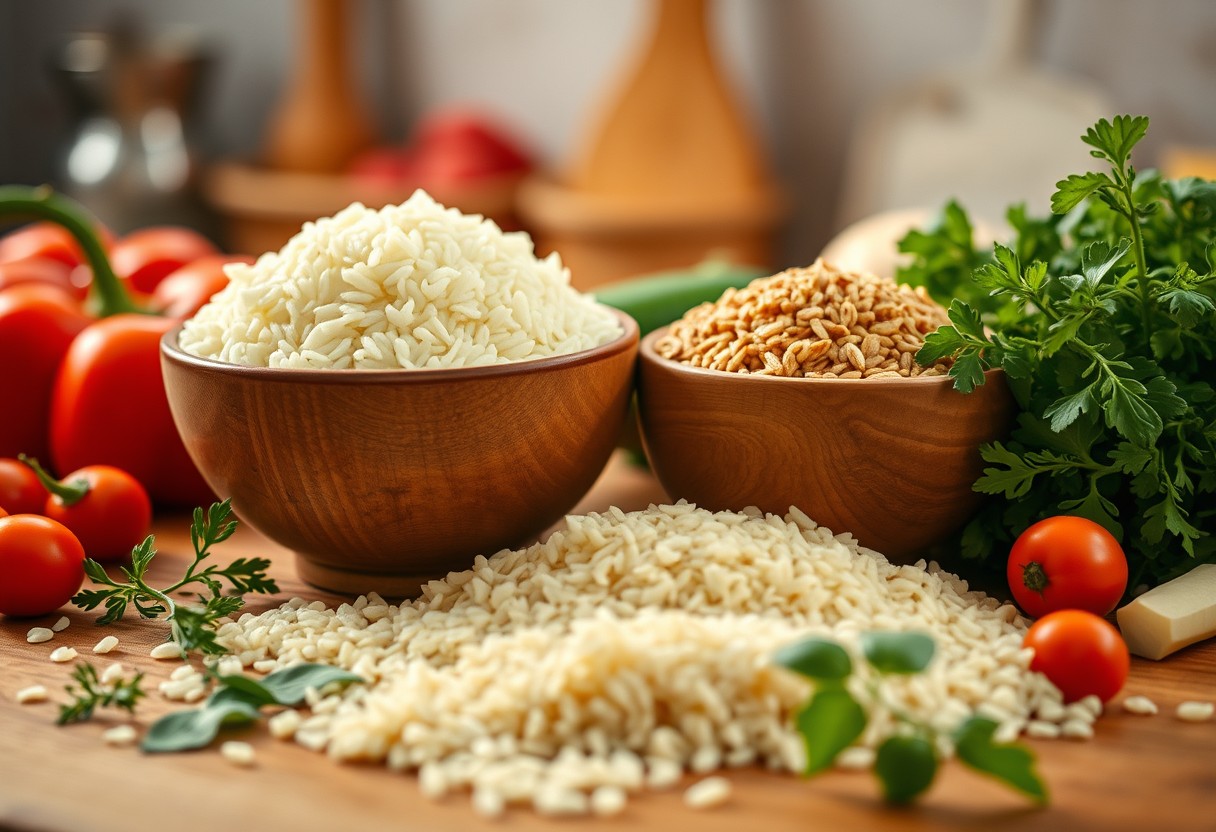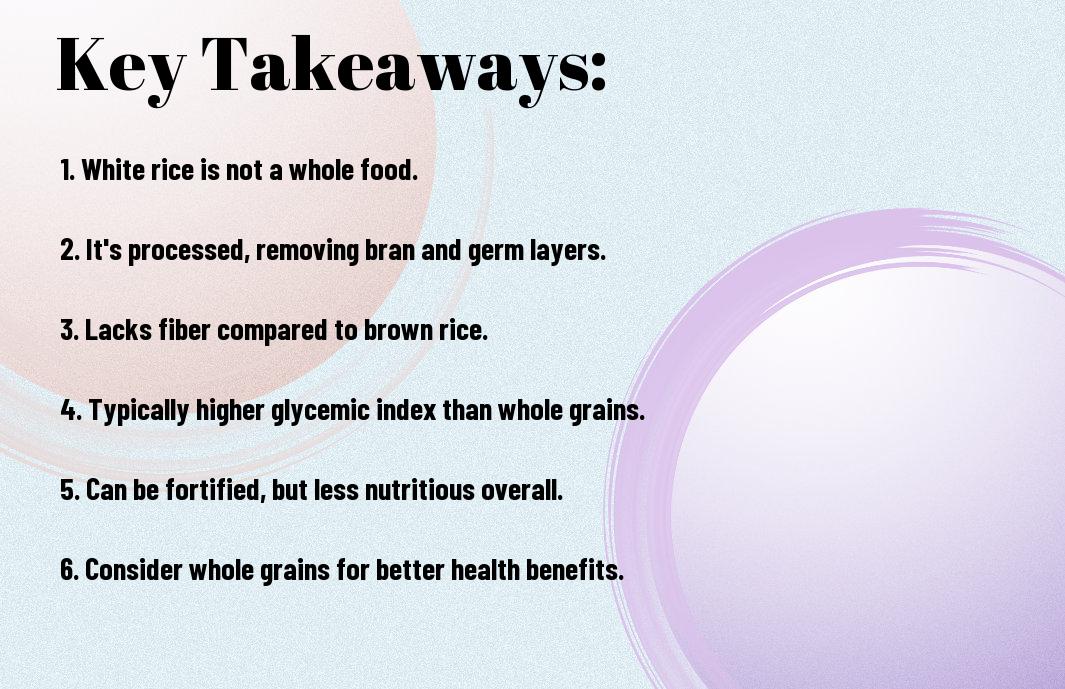It’s important to understand the distinction between whole foods and processed foods when making dietary choices. You may wonder if white rice qualifies as a whole food, given its popularity as a staple in many cuisines. In this post, we will explore what defines a whole food, the differences between white rice and its whole-grain counterpart, brown rice, and how this affects your nutritional intake. By the end, you’ll have a clearer understanding of where white rice fits in your diet.
Key Takeaways:
- Definition of Whole Food: Whole foods are minimally processed and retain their natural nutrients, fiber, and other beneficial compounds.
- Processing of White Rice: White rice is milled and polished, removing the bran and germ, which reduces its nutritional content.
- Comparison to Brown Rice: Brown rice is considered a whole food, offering higher levels of fiber, vitamins, and minerals compared to white rice.
- Impact on Health: Regular consumption of whole foods, including whole grains like brown rice, may contribute to better health outcomes compared to eating processed options like white rice.
- Consider Moderation: While white rice can be part of a balanced diet, it is necessary to consume it in moderation and alongside other whole foods.
Understanding Whole Foods
Before submerging into the specifics of white rice, it’s important to understand the concept of whole foods, as this classification significantly impacts your dietary choices and overall health.
Definition of Whole Foods
An important aspect of your nutrition journey is understanding that whole foods are unprocessed or minimally processed foods that retain their natural nutrients. They include fruits, vegetables, whole grains, nuts, seeds, and legumes, and are typically free from additives or artificial ingredients.
Nutritional Characteristics
Any whole food boasts a rich profile of vitamins, minerals, fiber, and antioxidants, which contribute to your overall health. Unlike processed foods, these foods provide a balanced source of nutrients that can support various bodily functions and promote well-being.
It’s crucial to note that the nutritional characteristics of whole foods vary. For instance, many whole grains, such as quinoa and brown rice, are high in fiber and important nutrients, while refined grains like white rice often undergo processing that strips away many of these beneficial qualities. Opting for whole foods allows you to maximize your nutrient intake and maintain a balanced diet.

The Nature of White Rice
Some people may wonder about the true nature of white rice, particularly when it comes to its classification as a whole food. Is it a healthy choice for your diet? To gain some clarity, you might find it helpful to explore the factors surrounding its processing and refinement as well as how it stacks up against its brown counterpart. Many sources discuss the differences extensively; for example, you can read about Brown Rice vs. White Rice: Which One Is Healthier?.
Processing and Refinement
On the way to the table, white rice undergoes significant processing that removes the bran and germ layers, resulting in a polished grain. This refinement strips away key nutrients such as fiber, vitamins, and minerals, making it less nutritious compared to its whole grain counterpart. The end product is stable and has a longer shelf life but lacks some of the whole food properties you might seek in your diet.
Comparison with Brown Rice
On the other side of the spectrum, brown rice is often praised for its nutritional benefits. It retains the bran and germ layers, which contain valuable nutrients. Let’s take a look at a simple comparison between white and brown rice to help you make an informed choice.
White Rice vs. Brown Rice
| Aspect | White Rice |
|---|---|
| Nutrient Density | Lower nutrient content |
| Fiber Content | Less fiber |
| Cooking Time | Generally quicker to cook |
| Shelf Life | Longer shelf life |
Nature has provided brown rice with a hearty nutritional profile that includes fiber, various vitamins, and imperative minerals, making it a more wholesome option for enhancing your overall diet. While you might enjoy the taste of white rice in a meal, consider the advantages of incorporating brown rice with its added health benefits. Making thoughtful choices can ultimately enhance your diet and well-being.
Additional Nutritional Comparison
| Nutrition | White Rice |
|---|---|
| Calories (per 1 cup cooked) | 205 |
| Protein (grams) | 4 |
| Carbohydrates (grams) | 45 |
| Fat (grams) | 0.4 |
Therefore, by understanding the nature of white rice and how it compares to brown rice, you can better decide how to incorporate it into your diet. While it offers convenience and a pleasing texture, consider alternate grains that align more closely with your health goals.
Nutritional Profile of White Rice
Once again, it’s important to investigate into the nutritional aspects of white rice to understand its place in your diet. While it may not be classified as a whole food due to its processing, analyzing its macronutrient and micronutrient profiles can help you evaluate its nutritional value and how it fits into your meals.
Macronutrients
Profile of white rice reveals that it is primarily composed of carbohydrates, providing about 45 grams of carbs per 1-cup serving when cooked. It contains minimal protein, around 4-5 grams, and is very low in fat, usually less than 1 gram. This composition makes white rice a quick source of energy, which can be beneficial in certain dietary routines.
Micronutrients
One of the notable aspects of white rice is its micronutrient content, which includes small amounts of necessary vitamins and minerals. Though it is lower in nutrients compared to whole grains, it still provides some B vitamins such as thiamine and niacin, as well as minerals like iron.
Rice varieties that are enriched may also contain added nutrients, helping to bridge the gap in your overall nutrient intake. However, it’s necessary to recognize that white rice lacks fiber and some key nutrients found in brown rice and other whole grains. Balancing your diet with a variety of foods can help ensure you meet your micronutrient needs effectively.
Dietary Considerations
Despite its popularity and cultural significance, white rice raises crucial dietary concerns regarding its classification as a whole food. Whole foods are typically defined as foods that are minimally processed and free from artificial substances. In this context, understanding how white rice fits into your overall diet is necessary for making informed dietary choices.
White Rice in Balanced Diets
On the surface, white rice can play a role in a balanced diet when consumed in moderation, particularly in conjunction with other nutrient-dense foods such as vegetables, proteins, and healthy fats. Its versatility makes it a staple in various cuisines, enabling you to incorporate it into meals while ensuring a variety of nutrients in your diet.
Health Implications
With its lower fiber content compared to whole grains, white rice may not provide the same health benefits. Diets high in refined carbohydrates, like those containing white rice, can contribute to blood sugar spikes and long-term health issues, such as obesity and type 2 diabetes.
Diets that heavily rely on white rice, while lacking in whole grains and other food groups, could lead to nutritional deficiencies. It’s necessary to balance your plate with whole foods rich in fiber, vitamins, and minerals to ensure optimal health. By diversifying your intake and including a variety of grains—like quinoa, brown rice, and barley—you can maximize nutrient absorption and maintain stable energy levels, contributing to a healthier lifestyle overall.

Summing up
Considering all points, you may conclude that white rice is not a whole food, as it undergoes significant processing that removes the bran and germ, stripping away many nutrients and fiber. While it still provides a source of carbohydrates and energy, opting for whole grains like brown rice or quinoa can offer more health benefits. Understanding the differences can help you make informed choices in your diet, ensuring you receive the nutrients your body deserves.
FAQ
Q: Is white rice considered a whole food?
A: No, white rice is not considered a whole food. Whole foods are typically defined as foods that are minimally processed and free from artificial ingredients or preservatives. White rice is milled and polished, which removes the bran and germ, stripping away many nutrients and fiber. This processing means it does not retain the qualities of a whole grain, such as brown rice, which is considered a whole food.
Q: What are the nutritional differences between white rice and whole grain rice?
A: The primary nutritional differences between white rice and whole grain rice lie in their fiber, vitamin, and mineral content. Whole grain rice, like brown rice, retains the bran and germ, providing more fiber, B vitamins, iron, and magnesium. In contrast, white rice has significantly lower fiber content and loses many of these nutrients during the refining process. This makes whole grain rice a healthier option for a balanced diet.
Q: Can white rice fit into a healthy diet despite not being a whole food?
A: Yes, white rice can fit into a healthy diet when consumed in moderation. While it lacks some of the nutritional benefits of whole grains, it is still a source of carbohydrates and can serve as a quick energy source. Pairing white rice with high-fiber vegetables, legumes, or protein sources can create a more balanced meal. Individuals with certain health conditions, such as digestive issues, may also find white rice easier to digest than whole grains, making it a suitable choice for them.


